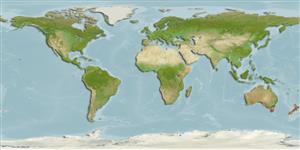Klassifizierung / Names
Namen | Synonyme | Catalog of Fishes(Gattung, Arten) | ITIS | CoL | WoRMS | Cloffa
Environment: milieu / climate zone / depth range / distribution range
Ökologie
seewasser demersal; tiefenbereich 0 - 7 m (Ref. 84085). Temperate
Southwest Pacific: southeastern Tasmania, Australia and New Zealand.
Size / Gewicht / Alter
Maturity: Lm ? range ? - ? cm
Max length : 7.6 cm SL Männchen/unbestimmt; (Ref. 13227)
Kurzbeschreibung
Bestimmungsschlüssel | Morphologie | Morphometrie
Rückenflossenstacheln (insgesamt) : 25 - 30; Rückenflossenweichstrahlen (insgesamt) : 14 - 16; Afterflossenstacheln: 2; Afterflossenweichstrahlen: 25 - 27; Wirbelzahl: 44 - 46. Snout profile steep, line drawn through tip of premaxilla across ventral margin of orbit touches or passes anterodorsal to dorsal extremity of preoperculum. Transverse groove in front of first
dorsal fin containing cephalic sensory pore. Scales absent in front of first dorsal fin first spine, naked immediately adjacent to first dorsal, but many small ctenoid scales adjacent to post-temporal. First lateral line scale with one group of ctenii at upper posterior edge, second scale onward, with two groups of ctenii at upper and middle posterior edges. Dorsal fin formula V-0N-0-1-0-1 (Ref. 84085).
Facultative air-breathing in the genus (Ref. 126274); Adults occur in rocky shores and occasionally in exposed rocky pools (Ref. 13227). Also common on wharf piles among encrusting invertebrates. Depth to at least 7 m (Ref. 84085).
Life cycle and mating behavior
Geschlechtsreife | Fortpflanzung | Ablaichen | Eier | Fecundity | Larven
Fricke, R., 1994. Tripterygiid fishes of Australia, New Zealand and the southwest Pacific Ocean (Teleostei). Theses Zool. 24:1-585. (Ref. 13227)
IUCN Rote Liste Status (Ref. 130435: Version 2024-2)
Bedrohung für Menschen
Harmless
Nutzung durch Menschen
Fischereien: nicht kommerziell
Tools
Zusatzinformationen
Download XML
Internet Quellen
Estimates based on models
Preferred temperature (Ref.
123201): 13.5 - 16.3, mean 15.3 °C (based on 137 cells).
Phylogenetic diversity index (Ref.
82804): PD
50 = 0.5039 [Uniqueness, from 0.5 = low to 2.0 = high].
Bayesian length-weight: a=0.00617 (0.00288 - 0.01322), b=3.04 (2.86 - 3.22), in cm total length, based on LWR estimates for this (Sub)family-body shape (Ref.
93245).
Trophic level (Ref.
69278): 3.3 ±0.4 se; based on size and trophs of closest relatives
Widerstandsfähigkeit (Ref.
120179): hoch, Verdopplung der Population dauert weniger als 15 Monate. (Preliminary K or Fecundity.).
Fishing Vulnerability (Ref.
59153): Low vulnerability (10 of 100).
Nutrients (Ref.
124155): Calcium = 209 [108, 585] mg/100g; Iron = 0.779 [0.388, 1.602] mg/100g; Protein = 18 [17, 19] %; Omega3 = 0.387 [0.157, 0.946] g/100g; Selenium = 9.32 [3.44, 24.44] μg/100g; VitaminA = 14.8 [3.1, 70.0] μg/100g; Zinc = 1.32 [0.79, 2.14] mg/100g (wet weight);
